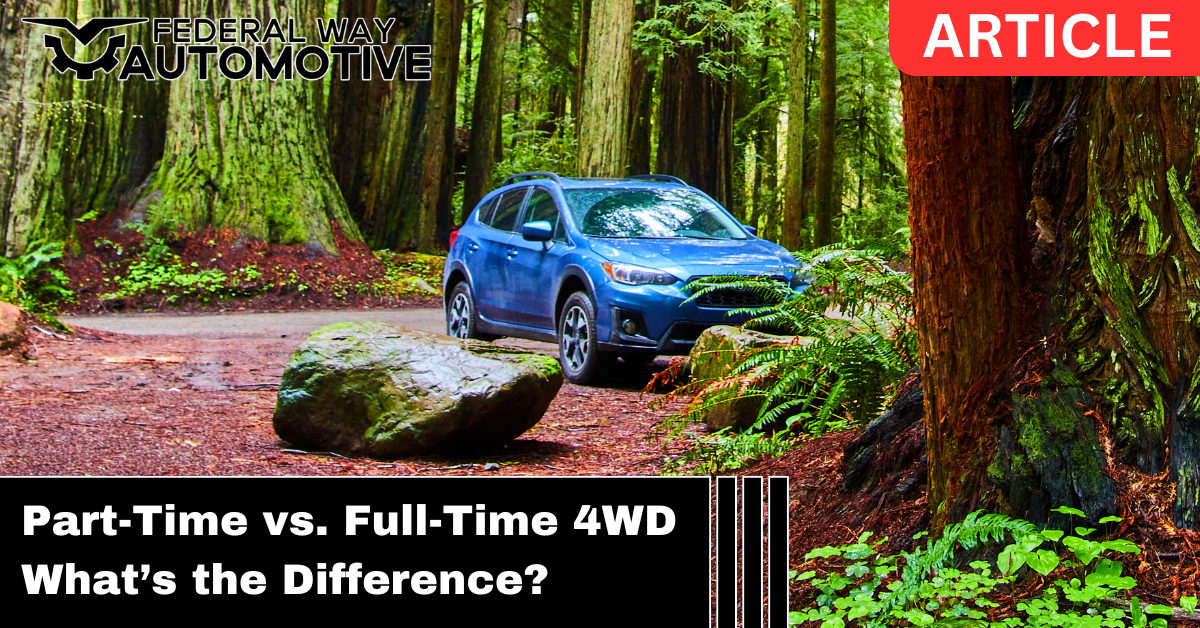If you’ve ever shopped for an SUV or truck, you’ve probably seen terms like “4WD,” “AWD,” “part-time 4WD,” and “full-time 4WD” tossed around like everyone’s supposed to know exactly what they mean. But for most drivers, those labels are confusing — and choosing the wrong system can mean wasted money, poor traction, or unnecessary wear on your drivetrain.
At Federal Way Automotive, we get questions about 4WD systems all the time — especially from drivers preparing for winter or who just want to understand what powers their vehicle. So let’s break down how each system works, what makes part-time 4WD different from full-time 4WD, and how it all compares to AWD.
We’ll also cover maintenance tips, what role your transfer case and differentials play, and which setup is best for your lifestyle and local weather.
What “4WD” Actually Means
Let’s start with the basics. “4WD” stands for four-wheel drive, which means power can be delivered to all four wheels simultaneously. That extra traction is extremely helpful when roads are slippery or when you’re off-road climbing over rocks, snow, or mud.
In a 4WD system, a transfer case splits power between the front and rear axles. Then, differentials — gear assemblies located between the wheels — allow those axles to rotate at slightly different speeds so you can turn smoothly.
But not all 4WD systems are created equal. The way power is distributed and the control you have over it depends on whether your vehicle uses part-time or full-time 4WD.
Part-Time 4WD — Traction When You Need It
Most pickup trucks and traditional off-road SUVs use part-time 4WD. The “part-time” part means exactly what it sounds like — the system is designed to be used some of the time, not all the time.
When you’re driving in normal conditions (dry pavement, city streets, highways), your vehicle operates in two-wheel drive — usually powering just the rear wheels. When traction gets tricky, you can manually engage 4WD, sending torque to both front and rear axles for extra grip.
How It Works
When you shift into 4WD (using a lever, dial, or button), the transfer case locks the front and rear driveshafts together. That equal split delivers traction to all four wheels.
There’s no center differential in this system, which means the front and rear wheels must rotate at the same speed. That’s fine on slippery surfaces, but it causes binding or “driveline wind-up” on dry pavement — one reason part-time 4WD should only be used on low-traction surfaces like snow, gravel, mud, or ice.
When to Use It
- During snow or ice storms
- Off-road driving or muddy trails
- Climbing steep gravel or dirt roads
- Towing on loose surfaces
When Not to Use It
- On dry or wet pavement with good traction
- At highway speeds when roads are clear
Using 4WD on dry roads can stress your drivetrain, wear out your transfer case, and damage your differentials or tires.
Pros of Part-Time 4WD
- Excellent traction when engaged
- Simple, rugged design
- Usually more fuel-efficient than full-time systems when in 2WD mode
- Easy to maintain and service
Cons of Part-Time 4WD
- Not meant for everyday use on pavement
- Requires manual engagement (driver input)
- Can cause binding or damage if used incorrectly
Common Vehicles with Part-Time 4WD
Toyota Tacoma, Jeep Wrangler, Ford Ranger, Chevrolet Silverado, and many classic off-road trucks.
Full-Time 4WD — Confidence All the Time
As the name suggests, full-time 4WD powers all four wheels all the time. Instead of switching between 2WD and 4WD, the system uses a center differential (often inside the transfer case) to allow different front and rear wheel speeds, just like a typical differential does between left and right wheels.
This setup gives you constant traction and stability — perfect for drivers who frequently deal with mixed or unpredictable conditions.
How It Works
Power flows continuously to both the front and rear axles through a center differential, which automatically splits torque as needed. Some systems use viscous couplings or electronic clutches to vary the torque distribution depending on road conditions.
You can often lock the center differential manually for better traction on rough or slippery terrain, turning your vehicle into a true “locked” 4WD setup when necessary.
When to Use It
- Ideal for everyday driving in rain, snow, or variable terrain
- Great for mountain or rural drivers who constantly encounter changing traction
- Perfect if you want 4WD capability without having to think about engaging it manually
Pros of Full-Time 4WD
- Always ready for slippery conditions
- Seamless operation — no need to switch modes
- Smoother, more stable handling on all surfaces
- Reduces driver error (no forgetting to engage 4WD before getting stuck)
Cons of Full-Time 4WD
- Slightly lower fuel economy than part-time systems
- More complex mechanics — higher repair costs if problems occur
- Some systems can wear tires faster if not rotated properly
Common Vehicles with Full-Time 4WD
Jeep Grand Cherokee, Land Rover Defender, Toyota Land Cruiser, and certain trims of the 4Runner and Ford Bronco.
AWD vs. 4WD — Clearing Up the Confusion
Many drivers confuse AWD (all-wheel drive) with 4WD, and it’s easy to see why. Both send power to all four wheels, but the way they do it — and their intended purpose — are quite different.
AWD systems are designed primarily for on-road driving and safety. They automatically adjust power between wheels when traction changes. Think of AWD as “set it and forget it” traction control for rain and light snow.
4WD systems, on the other hand, are built for strength, durability, and challenging terrain. They deliver higher torque and often include low-range gearing, making them ideal for towing, rock crawling, or deep snow.
Here’s a quick comparison:
| Feature | AWD | 4WD |
|---|---|---|
| Designed For | On-road traction and stability | Off-road and heavy-duty traction |
| Engagement | Automatic | Manual (part-time) or automatic (full-time) |
| Has Low-Range Gears | No | Yes |
| Best For | Rain, light snow, everyday use | Mud, rocks, steep hills, deep snow |
| Typical Vehicles | Crossovers, sedans | Trucks, SUVs |
If you spend most of your time on paved roads but still want extra grip in bad weather, AWD is great. If you regularly head off-road or tow in the mountains, 4WD is the way to go.
The Role of the Transfer Case and Differentials
Your transfer case is the heart of any 4WD system. It’s a heavy-duty gearbox that transfers power from the transmission to both the front and rear axles. Depending on your vehicle, it may include low-range gears for better control in extreme off-road situations.
Differentials — front, rear, and sometimes center — allow your wheels to rotate at different speeds. Without them, you wouldn’t be able to turn corners smoothly.
Some high-end 4WD systems include locking differentials, which force both wheels on an axle to turn at the same speed for maximum traction in mud or snow.
At Federal Way Automotive, our technicians inspect and service these components regularly. Fresh fluid in your transfer case and differentials prevents wear and ensures your 4WD engages smoothly when you need it most.
Maintenance Tips for 4WD Systems
No matter what kind of system you have — part-time, full-time, or AWD — proper maintenance keeps it performing its best. Here’s what to keep in mind:
- Change your transfer case fluid every 30,000–60,000 miles (or as recommended by your manufacturer).
- Inspect differential fluid at regular service intervals — dirty or low fluid can cause grinding and wear.
- Engage your 4WD system occasionally if you own a part-time 4WD. This keeps components lubricated.
- Rotate your tires regularly. Uneven tire wear can cause stress on AWD and full-time 4WD systems.
- Listen for noises when shifting in or out of 4WD. Clicking, grinding, or hesitation can indicate problems with the transfer case or differentials.
If you ever notice strange handling, vibrations, or a “binding” feeling when turning, it’s worth scheduling an inspection. Our ASE-certified team can test your system and make sure all components are operating smoothly.
Which System Is Right for You?
It depends on your driving habits, weather, and terrain.
Choose Part-Time 4WD if you:
- Drive mostly on paved roads but want off-road capability when needed.
- Want better fuel economy when not using 4WD.
- Don’t mind manually switching modes.
Choose Full-Time 4WD if you:
- Drive in unpredictable conditions (rain, snow, gravel) often.
- Prefer consistent traction and stability without switching settings.
- Tow, explore, or live where weather changes fast.
Choose AWD if you:
- Drive mainly on-road and want automatic traction in wet or light snow conditions.
- Want all-weather peace of mind without heavy-duty 4WD components.
No system is “best” for everyone — it’s all about matching your vehicle’s capability to your driving needs.
When to Have Your 4WD Inspected
If your 4WD system doesn’t engage, makes grinding noises, or the dashboard light flashes when you try to switch modes, don’t ignore it. These systems depend on precise mechanical engagement, and small problems can escalate quickly if left unchecked.
At Federal Way Automotive, we specialize in diagnosing and repairing 4WD and AWD systems — from fluid leaks in the transfer case to worn differentials and malfunctioning actuators. Our technicians use manufacturer-approved fluids and tools to ensure your vehicle performs like new.
Whether you’re preparing for winter, planning a road trip, or just want peace of mind that your traction system is ready, we’re here to help you drive with confidence.
Stay Confident in Every Condition
Whether you drive a rugged truck with part-time 4WD or a refined SUV with full-time 4WD, understanding your system helps you use it correctly and keep it running strong.
And if you’re ever unsure how your 4WD or AWD system should behave — or if you notice odd noises, vibrations, or hesitation — Federal Way Automotive is just a call away.
We’ll inspect your drivetrain, check your transfer case and differentials, and make sure everything’s ready for whatever the road (or trail) throws your way.
Drive smart, stay safe, and trust your 4WD to do its job — with a little help from the experts who keep it running right.


